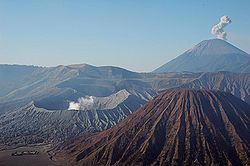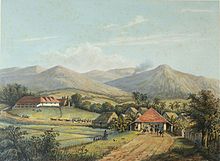- Java
-
This article is about the Indonesian island. For other uses, see Java (disambiguation).
Java Native name: Jawa 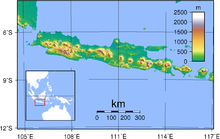
Topography of Java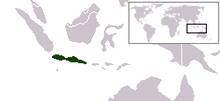
Geography Location Southeast Asia Coordinates 7°29′30″S 110°00′16″E / 7.49167°S 110.00444°ECoordinates: 7°29′30″S 110°00′16″E / 7.49167°S 110.00444°E Archipelago Greater Sunda Islands Area 128,297 km2 (49,535.7 sq mi) Area rank 13th Highest elevation 3,676 m (12,060 ft) Highest point Semeru Country Provinces Banten,
Jakarta Special Capital City District,
West Java,
Central Java,
East Java,
Yogyakarta Special RegionLargest city Jakarta Demographics Population 138 million (as of 2011) Density 1,064 /km2 (2,756 /sq mi) Ethnic groups Javanese (inc. Bantenese, Cirebonese, Tenggerese, Osing) , Sundanese (inc. Baduy), Betawi, Madurese Java (Indonesian: Jawa) is an island of Indonesia. With a population of 135 million (excluding the 3.6 million on Madura which is administered as part of Java), it is the world's most populous island, and one of the most densely populated regions in the world. It is home to 60% of Indonesia's population. The Indonesian capital city, Jakarta, is in west Java. Much of Indonesian history took place on Java; it was the centre of powerful Hindu-Buddhist empires, Islamic sultanates, the core of the colonial Dutch East Indies, and was at the centre of Indonesia's campaign for independence. The island dominates Indonesian social, political and economic life.
Formed mostly as the result of volcanic events, Java is the 13th largest island in the world and the fifth largest island in Indonesia. A chain of volcanic mountains forms an east-west spine along the island. It has three main languages, though Javanese is dominant and is the native language of 60 million people in Indonesia, most of whom live on Java. Most residents are bilingual, with Indonesian as their first or second language. While the majority of the people of Java are Muslim, Java has a diverse mixture of religious beliefs, ethnicities and cultures.
The island is divided into four provinces, West Java, Central Java, East Java, and Banten, and two special districts, Jakarta and Yogyakarta.
Contents
Etymology
The origins of the name 'Java' are not clear. One possibility is that the island was named after the jáwa-wut plant, which was said to be common in the island during the time, and that prior to Indianization the island had different names.[1] There are other possible sources: the word jaú and its variations mean "beyond" or "distant".[2] And, in Sanskrit yava means barley, a plant for which the island was famous.[2] "Yawadvipa" is mentioned in India's earliest epic, the Ramayana. Sugriva, the chief of Rama's army dispatched his men to Yawadvipa, the island of Java, in search of Sita.[3] It was hence referred to in Indian, specifically Tamil literature by the Sanskrit name "yāvaka dvīpa" (dvīpa = island). Another source states that the "Java" word is derived from a Proto-Austronesian root word, meaning 'home'.[4]
Geography
See also: Volcanoes of JavaJava lies between Sumatra to the west and Bali to the east. Borneo lies to the north and Christmas Island to the south. It is the world's 13th largest island. Java is surrounded by Java Sea in the north, Sunda Strait in the west, Indian Ocean in the south and Bali Strait and Madura Strait in the east.
Java is almost entirely of volcanic origin; it contains thirty-eight mountains forming an east-west spine which have at one time or another been active volcanoes. The highest volcano in Java is Mount Semeru (3,676 m). The most active volcano in Java and also in Indonesia is Mount Merapi (2,968 m). See Volcanoes of Java.
Further mountains and highlands help to split the interior into a series of relatively isolated regions suitable for wet-rice cultivation; the rice lands of Java are among the richest in the world.[5] Java was the first place where Indonesian coffee was grown, starting in 1699. Today, Coffea arabica is grown on the Ijen Plateau by small-holders and larger plantations.
The area of Java is approximately 139,000 km2.[6] The island's longest river is the 600 km long Solo River.[7] The river rises from its source in central Java at the Lawu volcano, then flows north and eastward to its mouth in the Java Sea near the city of Surabaya.
Temperatures throughout the year average 22°C to 29°C and humidity average 75%. The northern coastal plains are normally hotter averaging 34°C during the day in the dry season. The south coast is generally cooler than the north, and highland areas inland are cooler again. The wet season begins in October ending in April during which rain falls mostly in the afternoons and intermittently during other parts of the year. The wettest months are January and February.
West Java is wetter than East Java and mountainous regions receive much higher rainfall. The Parahyangan highlands of West Java receive over 4,000 mm annually, while the north coast of East Java receives 900 mm annually.
Administrative division
The island is administratively divided into four provinces:
- Banten, capital: Serang
- West Java, capital: Bandung
- Central Java, capital: Semarang
- East Java, capital: Surabaya
and one special region:
- Yogyakarta,
and one special capital district:
History
 Mount Merbabu surrounded by rice fields. Java's volcanic topography and rich agricultural lands are the fundamental factor in its history
Mount Merbabu surrounded by rice fields. Java's volcanic topography and rich agricultural lands are the fundamental factor in its history
Fossilised remains of Homo erectus, popularly known as the "Java Man", dating back 1.7 million years were found along the banks of the Bengawan Solo River.[8]
The island's exceptional fertility and rainfall allowed the development of wet-field rice cultivation, which required sophisticated levels of cooperation between villages. Out of these village alliances, small kingdoms developed. The chain of volcanic mountains and associated highlands running the length of Java kept its interior regions and peoples separate and relatively isolated.[9] Before the advent of Islamic states and European colonialism, the rivers provided the main means of communication, although Java's many rivers are mostly short. Only the Brantas and Sala rivers could provide long-distance communication, and thus their valleys supported the centres of major kingdoms. A system of roads, permanent bridges and toll gates is thought to have been established in Java by at least the mid-seventeenth century. Local powers could disrupt the routes as could the wet season and road use was highly dependent on constant maintenance. Subsequently, communication between Java's population was difficult.[10]
Hindu-Buddhist kingdoms era
The Taruma and Sunda kingdoms of western Java appeared in the fourth and seventh centuries respectively. However, the first major principality was the Medang Kingdom which was founded in central Java at the beginning of the eight century. Medang's religion centred on the Hindu god Shiva, and the kingdom produced some of Java's earliest Hindu temples on the Dieng Plateau. Around 8th century the Sailendra dynasty rose in Kedu Plain and become the patron of Mahayana Buddhism. This ancient kingdom built monuments such as 9th century Borobudur and Prambanan in central Java.
Around 10th century the centre of power shifted from central to eastern Java. The eastern Javanese kingdoms of Kediri, Singhasari and Majapahit were mainly dependent on rice agriculture, yet also pursued trade within the Indonesian archipelago with China and India.
Majapahit was established by Wijaya and by the end of the reign of Hayam Wuruk (r. 1350-89) it claimed sovereignty over the entire Indonesian archipelago, although control was likely limited to Java, Bali and Madura. Hayam Wuruk's prime minister, Gajah Mada, led many of the kingdom's territorial conquests. Previous Javanese kingdoms had their power based in agriculture, however, Majapahit took control of ports and shipping lanes and became Java's first commercial empire. With the death of Hayam Wuruk and the coming of Islam to Indonesia, Majapahit went into decline.
Spread of Islam and rise of Islamic sultanates
By the end of the 16th century, Islam, through conversion firstly amongst the island's elite, had surpassed Hinduism and Buddhism as the dominant religion in Java. During this era, the Islamic kingdoms of Demak, Cirebon, and Banten were ascendant. The Mataram Sultanate became the dominant power of central and eastern Java at the end of the 16th century. The principalities of Surabaya and Cirebon were eventually subjugated such that only Mataram and Banten were left to face the Dutch in the 17th century.
Colonial periods
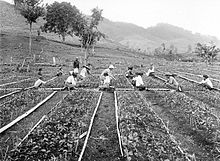 Tea plantation in Java during Dutch colonial period. In/before 1926.
Tea plantation in Java during Dutch colonial period. In/before 1926.
Java's contact with the European colonial powers began in 1522 with a treaty between the Sunda kingdom and the Portugese in Malacca. After its failure the Portugese presence was confined to Malacca, and to the eastern islands. In 1596, a four-ship expedition led by Cornelis de Houtman was the first Dutch contact with Indonesia.[11] By the end of the 18th century the Dutch had extended their influence over the sultanates of the interior (see Dutch East India Company in Indonesia). While the Javanese were great warriors, internal conflict prevented them forming effective alliances against the Dutch. Remnants of the Mataram survived as the Surakarta (Solo) and Yogyakarta principalities. Javanese kings claimed to rule with divine authority and the Dutch helped them to preserve remnants of a Javanese aristocracy by confirming them as regents or district officials within the colonial administration.
Java's major role during the early part of the colonial period was as a producer of rice. In spice producing islands like Banda, rice was regularly imported from Java, to supply the deficiency in means of subsistence.[12]
In 1811, Java was captured by the English, becoming a possession of the British Empire, and Sir Stamford Raffles was appointed as the island's Governor. In 1814, Java was returned to the Dutch under the terms of the Treaty of Paris.[13]
In 1815, there may have been 5 million people in Java.[14] In the second half of the eighteenth century, population spurts began in districts along the north-central coast of Java, and in the nineteenth century population grew rapidly across the island. Factors for the great population growth include the impact of Dutch colonial rule including the imposed end to civil war in Java, the increase in the area under rice cultivation, and the introduction of food plants such as casava and maize which could sustain populations that could not afford rice.[15] Others attribute the growth to the taxation burdens and increased expansion of employment under the Cultivation System to which couples responded by having more children in the hope of increasing their families' ability to pay tax and buy goods.[16] Cholera claimed 100,000 lives in Java in 1820.[17]
The advent of trucks and railways where there had previously only been buffalo and carts, telegraph systems, and more coordinated distribution systems under the colonial government all contributed to famine elimination in Java, and in turn, population growth. There were no significant famines in Java from the 1840s through to the Japanese occupation in the 1940s.[18] Ethnological factors are also thought to have contributed to the increase in population. In Java, there was no absolute preference for boy babies which was significant in Java where agriculture depends on the labour of both men and women. Furthermore, the age of first marriage dropped during the nineteenth century thus increasing a women's child bearing years.[18]
Independence Time
Indonesian nationalism first took hold in Java in the early twentieth century (see Indonesian National Awakening), and the struggle to secure the country's independence following World War II was centred in Java. The abortive coup and the subsequent violent anti-communist purge in 1965/66 largely took place in Java. The island has dominated Indonesian social, political and economic life, which has been the source of resentment. In 1998, preceding the fall of Suharto's 32-year presidency, large riots targeted the Chinese Indonesians in another series of pogroms.[19]
Demography
 Central Jakarta
Central Jakarta
With a combined population of 136.5 million in the 2010 census (including Madura's 3.6 million),[20] and at current growth rates, 139 million combined in 2011, is the most populous island in the world and is home to 57% of Indonesia's population.[20] At 1,062 people per km² in 2010 it is also one of the most densely-populated parts of the world. Though little population growth is registered in Central Java, East Java, and Yogyakarta, these regions have higher birth rates than one would assume due to mass emigration to the Western side of Java, Sumatra, Borneo, and Papua. Approximately 45% of the population of Indonesia is ethnically Javanese.,[21] Sundanese make a large portion of Java's population as well.
The dense Western third of the island (West Java, Banten, and DKI Jakarta) has an even higher population density exceeding 1,400 per km2 and is taking up the lion's share of population growth of Java.[20]
Province or Special District Capital Area
km²2)Area
%Population
Census of 2000[22]Population
Census of 2010[22]Population
Density in 2010Banten Serang 9,160.7 7.1 8,098,277 10,644,030 1,162 DKI Jakarta - 664 0.5 8,361,079 9,588,198 14,440 West Java Bandung 34,817 27.1 35,724,093 43,021,826 1,235 Central Java Semarang 32,801 25.3 31,223,258 32,380,687 995 Yogyakarta Yogyakarta 3,133 2.4 3,121,045 3,452,390 1,084 East Java Surabaya 47,922 37.3 34,765,993 37,476,011 782 Region Administered as Java Jakarta 128,297 100% 121,293,745 136,563,142 1,064 - Madura Island of East Java
- 4,250 3.3 3,230,300 3,621,646 852 - Java Island1)
- 124,047 96.7 118,063,445 132,941,496 1,071 1) Other islands are included in this figure but are very small in population and area
2) Land area of provinces updated in 2010 Census figures, areas may be different than past results.
From the 1970s to the fall of the Suharto regime in 1998, the Indonesian government ran transmigration programs aimed at resettling the population of Java on other less-populated islands of Indonesia. This program has met with mixed results; sometimes causing conflicts between the locals and the recently arrived settlers. However, Java's share of the nation's population has fallen steadily.
Jakarta and its outskirts being the dominant metropolis is also home to people from all over the nation. East Java is also home to ethnic Balinese, as well as large numbers of Madurans due to their historic poverty.
Ethnicity and culture
See also: Culture of Indonesia and Music of JavaThe Javanese kakawin Tantu Pagelaran explained the mythical origin of the island and its volcanic nature. Despite its large population and in contrast to the other larger islands of Indonesia, Java is comparatively homogeneous in ethnic composition. Only two ethnic groups are native to the island—the Javanese and Sundanese. A third group is the Madurese, who inhabit the island of Madura off the north east coast of Java, and have immigrated to East Java in large numbers since the 18th century.[23] The Javanese comprise about two-thirds of the island's population, while the Sundanese and Madurese account for 20% and 10% respectively.[23]
Four major cultural areas exist on the island: the kejawen or Javanese heartland, the north coast of the pasisir region, the Sunda lands of West Java, and the eastern salient, also known as Blambangan. Madura makes up a fifth area having close cultural ties with coastal Java.[23] The kejawen Javanese culture is the island's most dominant. Java's remaining aristocracy are based here, and it is the region from where the majority of Indonesia's army, business, and political elite originate. Its language, arts, and etiquette are regarded as the island's most refined and exemplary.[23] The territory from Banyumas in the west through to Blitar in the east and encompasses Indonesia's most fertile and densely populated agricultural land.[23]
In the southwestern part of Central Java, which is usually named the Banyumasan region, a cultural mingling occurred; bringing together Javanese culture and Sundanese culture to create the Banyumasan culture.[citation needed] In the central Javanese court cities of Yogyakarta and Surakarta, contemporary kings trace their lineages back to the pre-colonial Islamic kingdoms that ruled the region, making those places especially strong repositories of classical Javanese culture. Classic arts of Java include gamelan music and wayang puppet shows.
Java was the site of many influential kingdoms in the Southeast Asian region,[24] and as a result, many literary works have been written by Javanese authors. These include Ken Arok and Ken Dedes, the story of the orphan who usurped his king, and married the queen of the ancient Javanese kingdom; and translations of Ramayana and Mahabharata. Pramoedya Ananta Toer is a famous contemporary Indonesian author, who has written many stories based on his own experiences of having grown up in Java, and takes many elements from Javanese folklore and historical legends.
Languages
The three major languages spoken on Java are Javanese, Sundanese and Madurese. Other languages spoken include Betawi (a Malay dialect local to the Jakarta region), Osing and Tenggerese (closely related to Javanese), Baduy (closely related to Sundanese), Kangeanese (closely related to Madurese), Balinese, and Banyumasan[25] The vast majority of the population also speaks Indonesian, often as a second language.
Religion
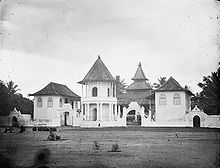 Mosque in Pati, Central Java during colonial period. The mosque combined traditional Javanese style (multi-tiered roof) with European architecture.
Mosque in Pati, Central Java during colonial period. The mosque combined traditional Javanese style (multi-tiered roof) with European architecture.
More than 90 percent of the people of Java are Muslims, on a broad continuum between abangan (more traditional) and santri (more modernist). Small Hindu enclaves are scattered throughout Java, but there is a large Hindu population along the eastern coast nearest Bali, especially around the town of Banyuwangi. There are also Christian communities, mostly in the larger cities, though some rural areas of south-central Java are strongly Roman Catholic. Roman Catholics and other Christian groups have been persecuted for their beliefs such as a ban on Christmas services.[26] Buddhist communities also exist in the major cities, primarily among the Chinese Indonesian. The Indonesian constitution recognises six official religions. (See Religion in Indonesia.)
Java has been a melting pot of religions and cultures, which has created a broad range of religious belief. Indian influences came first with Shaivism and Buddhism penetrating deeply into society, blending with indigenous tradition and culture.[27] One conduit for this were the ascetics, called resi, who taught mystical practices. A resi lived surrounded by students, who took care of their master's daily needs. Resi's authorities were merely ceremonial. At the courts, Brahmin clerics and pudjangga (sacred literati) legitimised rulers and linked Hindu cosmology to their political needs.[27]
Islam, which came after Hinduism, strengthened the status structure of this traditional religious pattern. The Muslim scholar of the writ (Kyai) became the new religious elite as Hindu influences receded. Islam recognises no hierarchy of religious leaders nor a formal priesthood, but the Dutch colonial government established an elaborate rank order for mosque and other Islamic preaching schools. In Javanese pesantren (Islamic schools), The Kyai perpetuated the tradition of the resi. Students around him provided his needs, even peasants around the school.[27]
Pre-Islamic Javan traditions have encouraged Islam in a mystical direction. There emerged in Java a loosely structured society of religious leadership, revolving around kyais, possessing various degrees of proficiency in pre-Islamic and Islamic lore, belief and practice.[27] The kyais are the principal intermediaries between the villages masses and the realm of the supernatural. However, this very looseneess of kyai leadership structure has promoted schism. There were often sharp divisions between orthodox kyais, who merely instructed in Islamic law, with those who taught mysticism and those who sought reformed Islam with modern scientific concepts. As a result, there is a division between santri, who believe that they are more orthodox in their Islamic belief and practice, with abangan, who have mixed pre-Islamic animistic and Hindu-Indian concepts with a superficial acceptance of Islamic belief.[27]
A wider effect of this division is the number of sects. In the middle of 1956, the Department of Religious Affairs in Yogyakarta reported 63 religious sects in Java other than the official Indonesian religions. Of these, 35 were in Central Java, 22 in West Java and 6 in East Java.[27] These include Kejawen, Sumarah, Subud, etc. Their total membership is difficult to estimate as many of their adherents identify themselves with one of the official religions.[28]
Economy
Initially the economy of Java relied heavily on rice agriculture. Ancient kingdoms such as the Tarumanagara, Mataram, and Majapahit were dependent on rice yields and tax. Java was famous for rice surpluses and rice export since ancient times, and rice agriculture contributed to the population growth of the island. Trade with other parts of Asia such as India and China flourished as early as the 4th century, as evidenced by Chinese ceramics found on the island dated to that period. Java also took part in the global trade of Maluku spice from ancient times in the Majapahit era, until well into the VOC era.
Dutch East India Company set their foothold on Batavia in 17th century and was succeeded by Netherlands East Indies in 18th century. During these colonial times, the Dutch introduced the cultivation of commercial plants in Java, such as sugarcane, rubber, coffee, tea, and quinine. In the 19th and early 20th century, Javanese coffee gained global popularity. Thus, the name "Java" today has become a synonym for coffee.
Java is the most developed island in Indonesia since the era of Netherlands East Indies to modern Republic of Indonesia. The road transportation networks that have existed since ancient times were connected and perfected with the construction of Java Great Post Road by Daendels in the early 19th century. The need to transport commercial produces such as coffee from plantations in the interior of the island to the harbour on the coast spurred the construction of railway networks in Java. Today the industry, business and trade, also services flourished in major cities of Java, such as Jakarta, Surabaya, Semarang, and Bandung; while some traditional Sultanate cities such as Yogyakarta, Surakarta, and Cirebon preserved its royal legacy and become the centre of art, culture and tourism in Java. Industrial estates also growing in towns on northern coast of Java, especially around Cilegon, Tangerang, Bekasi, Karawang, Gresik and Sidoarjo. The toll road highway networks was built and expanded since Suharto era until now, connecting major urban centres and surrounding areas, such as in and around Jakarta and Bandung; also the ones in Cirebon, Semarang and Surabaya. In addition to these motorways, Java has 16 national highways.
See also
- The spread of Islam in Indonesia (1200 to 1600)
- List of monarchs of Java
- History of Indonesia
Notes
- ^ Raffles, Thomas E. : " The History of Java". Oxford University Press, 1965. Page 2
- ^ a b Raffles, Thomas E. : "The History of Java". Oxford University Press, 1965 . Page 3
- ^ History of Ancient India Kapur, Kamlesh
- ^ Hatley, R., Schiller, J., Lucas, A., Martin-Schiller, B., (1984). "Mapping cultural regions of Java" in: Other Javas away from the kraton. pp. 1–32.
- ^ Ricklefs, M.C. (1991). A History of Modern Indonesia since c.1300 (2nd edition). London: MacMillan. pp. 15. ISBN 0-333-57690-X.
- ^ Monk,, K.A.; Fretes, Y., Reksodiharjo-Lilley, G. (1996). The Ecology of Nusa Tenggara and Maluku. Hong Kong: Periplus Editions Ltd.. p. 7. ISBN 962-593-076-0.
- ^ Management of Bengawan Solo River Area Jasa Tirta I Corporation 2004. Retrieved 26 July 2006
- ^ Pope, G G (1988). "Recent advances in far eastern paleoanthropology". Annual Review of Anthropology 17: 43–77. doi:10.1146/annurev.an.17.100188.000355. cited in Whitten, T; Soeriaatmadja, R. E., Suraya A. A. (1996). The Ecology of Java and Bali. Hong Kong: Periplus Editions Ltd. pp. 309–312.; Pope, G (August 15, 1983). "Evidence on the Age of the Asian Hominidae". Proceedings of the National Academy of Sciences of the United States of America 80 (16): 4,988–4992. doi:10.1073/pnas.80.16.4988. PMC 384173. PMID 6410399. http://www.pubmedcentral.nih.gov/articlerender.fcgi?tool=pmcentrez&artid=384173. cited in Whitten, T; Soeriaatmadja, R. E., Suraya A. A. (1996). The Ecology of Java and Bali. Hong Kong: Periplus Editions Ltd. pp. 309.; de Vos, J.P.; P.Y. Sondaar, (9 December 1994). "Dating hominid sites in Indonesia" (PDF). Science Magazine 266 (16): 4,988–4992. doi:10.1126/science.7992059. http://www.sciencemag.org/cgi/reprint/266/5191/1726.pdf. cited in Whitten, T; Soeriaatmadja, R. E., Suraya A. A. (1996). The Ecology of Java and Bali. Hong Kong: Periplus Editions Ltd. pp. 309.
- ^ Ricklefs (1991), pp. 16–17
- ^ Ricklefs (1991), p. 15.
- ^ Ames, Glenn J. (2008). The Globe Encompassed: The Age of European Discovery, 1500-1700. p. 99.
- ^ St. John, Horace Stebbing Roscoe (1853). The Indian Archipelago: its history and present state, Volume 1. Longman, Brown, Green, and Longmans. pp. 137. http://books.google.com.my/books?id=UJ9FAAAAIAAJ.
- ^ Atkins, James (1889). The Coins And Tokens Of The Possessions And Colonies Of The British Empire. London: Quaritch, Bernard. pp. 213.
- ^ Java (island, Indonesia). Encyclopædia Britannica.
- ^ Taylor (2003), p. 253.
- ^ Taylor (2003), pp. 253-254.
- ^ Byrne, Joseph Patrick (2008). Encyclopedia of Pestilence, Pandemics, and Plagues: A-M. ABC-CLIO. p. 99. ISBN 0313341028. http://books.google.com/books?id=5Pvi-ksuKFIC&pg=PA99&dq#v=onepage&q=&f=false.
- ^ a b Taylor (2003), p. 254.
- ^ "Ethnic Chinese tell of mass rapes". BBC News. 23 June 1998. http://news.bbc.co.uk/1/hi/events/indonesia/special_report/118576.stm. Retrieved 28 April 2010.
- ^ a b c http://www.thejakartapost.com/news/2010/08/23/population-growth-%E2%80%98good-papua%E2%80%99.html
- ^ CIA factbook
- ^ a b http://www.citypopulation.de/Indonesia-MU.html
- ^ a b c d e Hefner, Robert (1997). Java. Singapore: Periplus Editions. pp. 58. ISBN 962-593-244-5.
- ^ See Wallace Stevens's poem "Tea" for an appreciative allusion to Javanese culture.
- ^ Languages of Java and Bali – Ethnologue. Other sources may list some of these as dialects rather than languages.
- ^ Epa, Konradus. "Christians refuse to cancel Christmas". UCA News. http://www.ucanews.com/2010/12/23/christians-refuse-to-cancel-christmas/.
- ^ a b c d e f van der Kroef, Justus M. (1961). "New Religious Sects in Java". Far Eastern Survey 30 (2): 18–15. doi:10.1525/as.1961.30.2.01p1432u. JSTOR 3024260.
- ^ Beatty, Andrew, Varieties of Javanese Religion: An Anthropological Account, Cambridge University Press 1999, ISBN 0-521-62473-8
References
- Taylor, Jean Gelman (2003). Indonesia: Peoples and Histories. New Haven and London: Yale University Press. ISBN 0-300-10518-5.
Further reading
- Cribb, Robert (2000). Historical Atlas of Indonesia. London and Honolulu: RoutledgeCurzon Press, University of Hawaii Press. ISBN 0-8248-2111-4.
External links
Provinces of Indonesia Sumatra Aceh · Bangka–Belitung Islands · Bengkulu · Jambi · Lampung · North Sumatra · Riau · Riau Islands · South Sumatra · West SumatraJava Kalimantan Lesser Sunda Sulawesi Maluku Western New Guinea Papua · West PapuaCategories:
Wikimedia Foundation. 2010.

